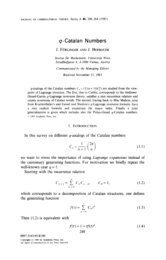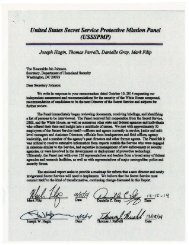010815as1
Create successful ePaper yourself
Turn your PDF publications into a flip-book with our unique Google optimized e-Paper software.
sharing network and $231 million spent, the program was only being used regularly by a fraction<br />
of the universe of federal, state, and local officials and law enforcement representatives who<br />
were intended to benefit from DHS’s information sharing network. 78 The DHS Inspector<br />
General found that the HSIN had “35,560 active account holders nationwide,” as of October<br />
2012, but that only 4 percent of these users logged in to the system on a daily basis. 79 Only 12<br />
percent, or roughly 4,270 people, checked the system at least once a week. 80 Among the reasons<br />
for the network’s limited use cited by state and local officials was that “the system content was<br />
not useful.” 81<br />
Besides these information sharing mechanisms, DHS’s intelligence mission was also<br />
intended to provide utility for the federal government, state and local partners, and the private<br />
sector by conducting analysis and reporting useful information and assessments about security<br />
risks, including terrorism threats. But evidence casts doubt about the usefulness of the<br />
Department’s Office of Intelligence and Analysis (I&A) and its intelligence products. For<br />
example, an analysis conducted by the Senate Select Committee on Intelligence found that in<br />
2013, DHS had more analysts than finished intelligence products, meaning that DHS I&A<br />
produced less than one product per analyst that year. 82 A June 2014 report by the Government<br />
Accountability Office (GAO) raised additional questions about the usefulness of the intelligence<br />
that the DHS Office of Intelligence and Analysis’s does produce. Surveys revealed that three key<br />
groups that I&A envisions to be the customers of its intelligence products—specifically, DHS’s<br />
components, the Intelligence Community, and private critical infrastructure sector—did not<br />
find I&A’s products to be useful. 83 GAO reported that the Department’s own components, for<br />
example, “generally stated that they did not consider themselves customers of I&A with regard<br />
to finished intelligence products.” 84<br />
78 Department of Homeland Security Office of Inspector General, “Homeland Security Information Network<br />
Improvements and Challenges,” OIG 13-98, June, 2013.<br />
79 Ibid, p.15-16.<br />
80 Ibid, p.16.<br />
81 Ibid, p.17.<br />
82 Opening Statement of Senator Tom Coburn, Senate Homeland Security and Governmental Affairs Committee,<br />
“Hearing on the Nominations of L. Reginald Brothers, Jr., to be Under Secretary of Science and Technology, U.S.<br />
Department of Homeland Security, and Hon. Francis X. Taylor to be Under Secretary of Intelligence and Analysis,<br />
U.S. Department of Homeland Security,” March 5, 2014.<br />
83 Government Accountability Office, “DHS Intelligence Analysis: Additional Actions Needed to Address Analytic<br />
Priorities and Workforce Challenges,” GAO 14-397, June 2014.<br />
84 Ibid, p.21.<br />
24








![55721335-d6fe09eb5ffdcc87dbf6c3f0b5bbda07d2261e98[1]](https://img.yumpu.com/56533583/1/186x260/55721335-d6fe09eb5ffdcc87dbf6c3f0b5bbda07d2261e981.jpg?quality=85)








